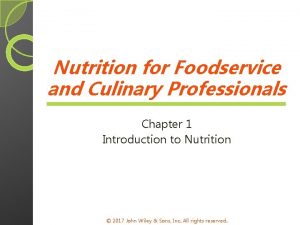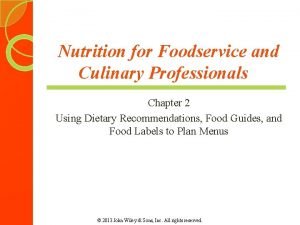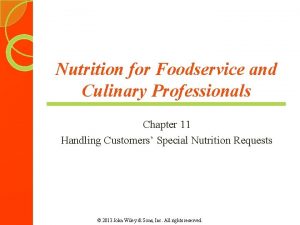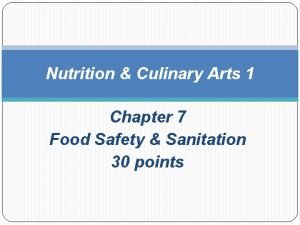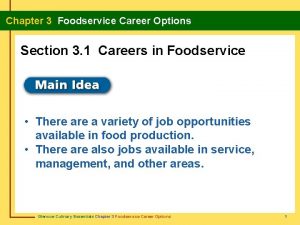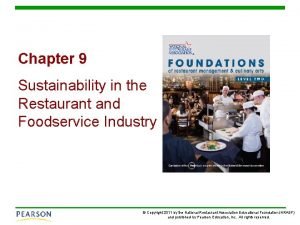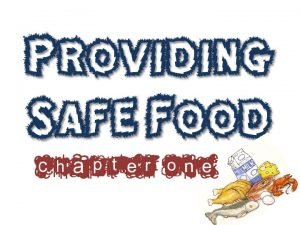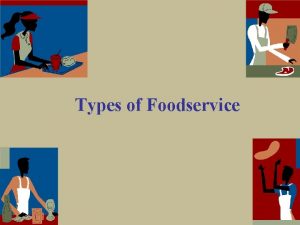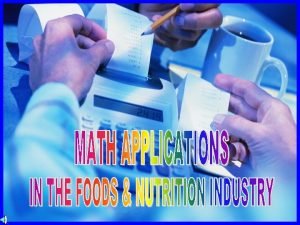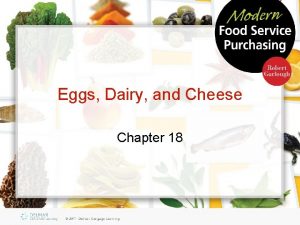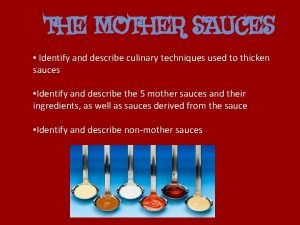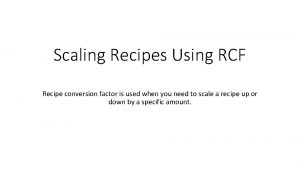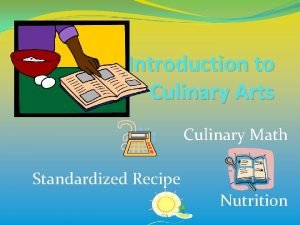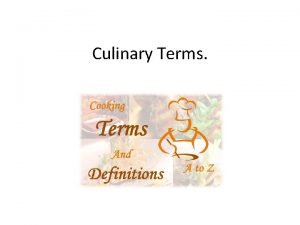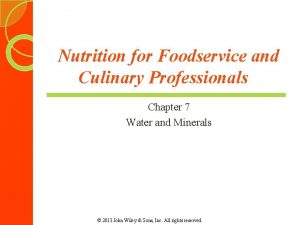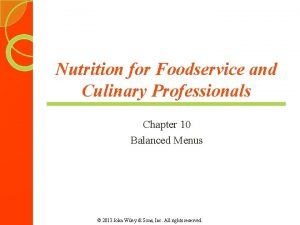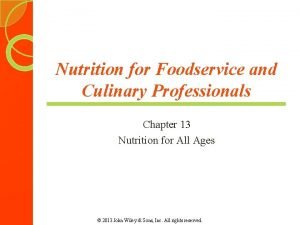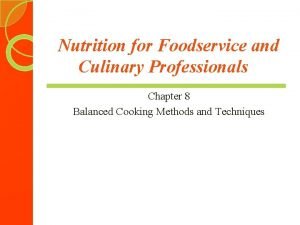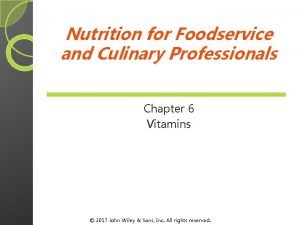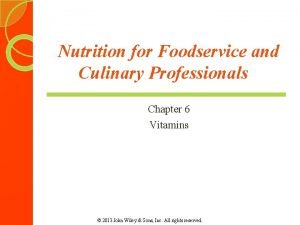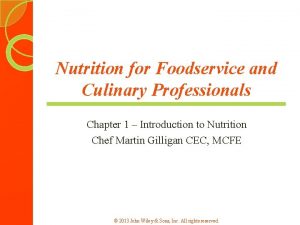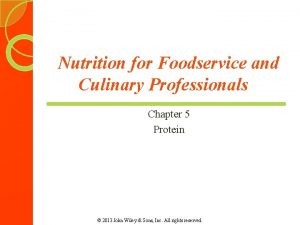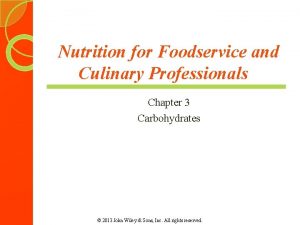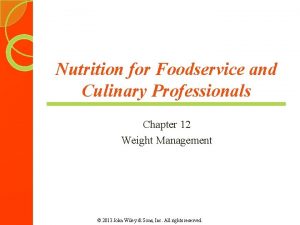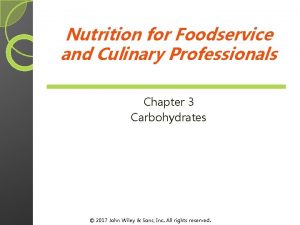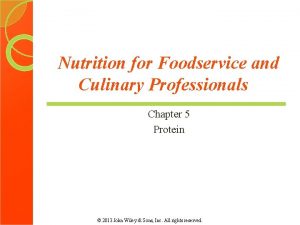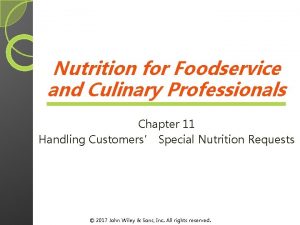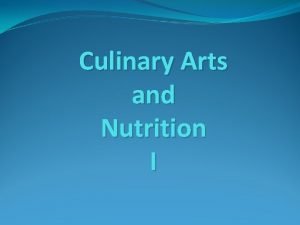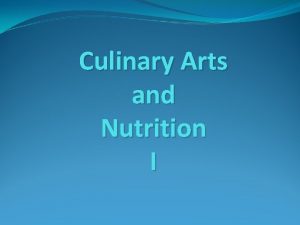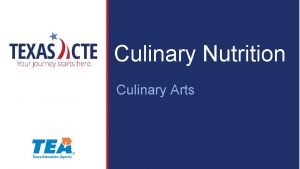Nutrition for Foodservice and Culinary Professionals Chapter 1


































- Slides: 34

Nutrition for Foodservice and Culinary Professionals Chapter 1 Introduction to Nutrition © 2013 John Wiley & Sons, Inc. All rights reserved.

Nutrition and You What is nutrition? � A young science. � Looks at nutrients—the nourishing substances in food that provide energy and promote the growth and maintenance of the body. � Looks at how nutrients and other substances in food relate to health and disease. � Explores why you choose the foods you do – in other words, the type of diet you eat. © 2013 John Wiley & Sons, Inc. All rights reserved.

Diet and Disease � Our choice of diet strongly influence whether we will get certain diseases such as: ◦ Heart disease ◦ Cancer ◦ Stroke � U. S. Epidemic: Overweight and Obesity ◦ 72% of men and 64% of women are overweight or obese. ◦ 32% of children ages 2 to 19 years are overweight or obese. © 2013 John Wiley & Sons, Inc. All rights reserved.

Diet and Disease (cont’d) � What contributes to obesity? Diet and inactivity. can obesity lead to? Diabetes, heart disease, high blood pressure. � Eating healthy can reduce your risk of: ◦ Heart disease ◦ High blood pressure ◦ Diabetes ◦ Several types of cancer Healthy Foods* Fruits Vegetables Whole grains Beans and peas Fat-free of low-fat dairy Lean meats, poultry Seafood * All with minimal solid fat, sugar, or sodium © 2013 John Wiley & Sons, Inc. All rights reserved. Nuts and seeds

How the US Diet Compares to Recommendations © 2013 John Wiley & Sons, Inc. All rights reserved.

A look at restaurant customers � In 2011, the National Restaurant Association reported that 71% of adults are trying to eat healthier at restaurants than two years earlier. � Restaurant customers have been ordering healthier foods, such as grilled chicken and fruit, and less high-sugar (such as soda) and high-fat (such as hot dogs) foods. © 2013 John Wiley & Sons, Inc. All rights reserved.

Top Trends in Food and Beverages and Culinary � Nutrition/health � Gluten-free/food-allergy conscious � Sustainability and locally grown and sourced foods � Children’s nutrition and healthful kids’ meals with whole grains, fruits, and vegetables � Restaurant gardens © 2013 John Wiley & Sons, Inc. All rights reserved.

Why You Eat the Foods You Do � Flavor � Other aspects of food (cost, convenience, nutrition) � Demographics � Culture and religion � Health � Social and emotional influences � Marketing and the media � Environmental concerns © 2013 John Wiley & Sons, Inc. All rights reserved.

Flavor � Includes taste, smell, texture or mouthfeel, temperature, and sounds. � Flavor is a combination of all five senses (taste, smell, touch, sight, and sound). � The most important consideration when choosing something to eat is taste. © 2013 John Wiley & Sons, Inc. All rights reserved.

Taste � You have about 10, 000 taste buds on your tongue, cheeks, throat, and roof of the mouth. � Taste buds for each sensation are scattered around the mouth. � Children under six have more taste buds, and adults over 50 start to lose taste buds. © 2013 John Wiley & Sons, Inc. All rights reserved.

Five Primary Taste Sensations Sweet Sour Salty Bitter Unami � Umami ◦ Umami provides a savory, sometimes meaty, sensation. ◦ Umami taste receptor is very sensitive to glutamate—an amino acid found in protein such as meat, fish, and milk, and in the flavor enhancer MSG. ◦ Umami flavor increases when salt is added (ketchup, soy sauce, fish sauce). � The heat of hot peppers is felt not by the taste buds but by pain receptors in the mouth that sense heat. © 2013 John Wiley & Sons, Inc. All rights reserved.

Smell � Smell is very important to taste. � Receptors in your nose can distinguish among about 10, 000 scents. � While cooking and while eating, you smell food. � The sense of smell and detecting the aromas in wine are how wine is tasted. © 2013 John Wiley & Sons, Inc. All rights reserved.

Texture or Mouthfeel Textures that people like: � Crispy � Juicy � Creamy � Tender � Firm � Crunchy Textures people generally don’t like: � Tough � Crumbly � Lumpy � Soggy � Watery Textures influence whether you like the food, and also tells you whether the food is fresh. © 2013 John Wiley & Sons, Inc. All rights reserved.

Other Influences on What You Eat � Health concerns (such as dieting) � Social influences (peer pressure) � Emotional influences (comfort foods) � Marketing and the media � Environmental concerns � Culture and Religion � Demographics (age, gender, education, income etc. ) © 2013 John Wiley & Sons, Inc. All rights reserved.

“Eat with Your Eyes” �https: //www. youtube. com/watch? v=_idk- BDeal 4 © 2013 John Wiley & Sons, Inc. All rights reserved.

What are Kilocalories? �A measure of the energy in food � One kilocalorie raises the temperature of one kilogram of water one degree Celsius. � Abbreviated as kcalorie or kcal. � When you hear “calorie, ” it is really a kilocalorie. 1. Basal metabolism (about two-thirds of total energy needs for individuals who are not very active) 2. Physical activity 3. Energy used to digest and absorb food (about 10% of total energy needs) © 2013 John Wiley & Sons, Inc. All rights reserved.

BMR (Basic Metabolic Rate)factors : Gender Height Exercise Age Temperature Smoking and caffeine Growth Fever and stress Sleep Physical activity accounts for 25 to 40 percent of your total energy needs. © 2013 John Wiley & Sons, Inc. All rights reserved.

What Are Nutrients? � Carbohydrates � Fats (4 kcal/g) (9 kcal/g) � Proteins (4 kcal/g) � Vitamins � Minerals � Water No kcalories in vitamins, minerals, or water. Alcohol supplies 7 kcal/g but is NOT a nutrient because it does not promote growth or maintenance of the body. © 2013 John Wiley & Sons, Inc. All rights reserved.

Macronutrients vs. Micronutrients What are the differences between Macro and Micro nutrients? What do nutrients do? *regulate body processes. *maintain the body. *allow growth and reproduction. 1. Macronutrients 2. Micronutrients � Carbohydrates � Vitamins � Fats � Minerals � Proteins © 2013 John Wiley & Sons, Inc. All rights reserved.

Characteristics of a Nutritious Diet (Is it fortified, enriched, whole or processed food? ) Fortification: a food is fortified when nutrients are added that were not present originally, or nutrients are added that increase the amount already present. ◦ Example: calcium in orange juice � Enrichment: a food is enriched when nutrients are added to replace nutrients that were lost in processing. ◦ Example: breads enriched with iron and several B vitamins � Whole foods: Foods pretty much as we get them from nature (eggs, fresh fruits and vegetables, beans and peas, whole grains, fresh meat, milk) Processed foods: food prepared using milling, cooking, freezing, canning, dehydrating, or culturing with bacteria (bread, cookies, cereals, sauces, soups, baking mixes, frozen entrees, pasta, snack foods) © 2013 John Wiley & Sons, Inc. All rights reserved.

Dietary Reference Intakes (DRI) Recommended Dietary Allowance (RDA) How much you need to take in on a daily basis. Adequate Intake (AI) Intake value used when an RDA cannot be established because there’s not enough scientific data. Tolerable Upper Intake Level (UL) Maximum intake level above which toxicity would increase. � Acceptable Macronutrient Distribution Ranges (AMDR) for adults ◦ Carbohydrate 45– 65% ◦ Fat 20– 35% ◦ Protein 10– 35% © 2013 John Wiley & Sons, Inc. All rights reserved.

What is nutrient density? And What is an Empty K-kalorie food? � Nutrient density is a measure of the nutrients provided in a food per kcalorie of that food. � Empty-kcalorie foods provide few nutrients for the number of kcalories they contain. © 2013 John Wiley & Sons, Inc. All rights reserved.

Nutrient Density Comparison: % DRI Intakes for Selected Nutrients Nutritious diet: � Adequate � Balanced � Moderate � Varied © 2013 John Wiley & Sons, Inc. All rights reserved.

What Happens When You Eat? The Gastrointestinal Tract © 2013 John Wiley & Sons, Inc. All rights reserved.

The Digestive System © 2013 John Wiley & Sons, Inc. All rights reserved.

The Digestive System (cont’d) Small Intestine Large Intestine • Nutrients are still being digested. • Site of most nutrient absorption. • Most nutrients pass through villi into blood vessels—or are transported to the blood. • Nutrients travel in the blood throughout the body where they can enter the cells. • Connects small intestine to the rectum. • Receives waste products of digestion and passes them on to rectum. • Absorbs water, some minerals, and a few vitamins (such as vitamin K) made by bacteria residing there. © 2013 John Wiley & Sons, Inc. All rights reserved.

Carbohydrates: �A large class of nutrients, including: ◦ Sugars ◦ Starch ◦ Fibers � Sugars and starches function as the body’s primary source of energy. © 2013 John Wiley & Sons, Inc. All rights reserved.

Fats and Oils � Fats and oils provide a rich source of energy. � Examples: ◦ Butter ◦ Margarine ◦ Vegetable oils ◦ Mayonnaise ◦ Salad dressings © 2013 John Wiley & Sons, Inc. All rights reserved.

Fats and Oils (cont’d) Found in: � Fatty streaks in meat � Poultry skin � Fat in milk, cheese, ice cream � Baked goods � Fried foods � Nuts Foods with little to no fat: � Vegetables � Pasta � Bread � Cereals � Fat-free milk and cheese © 2013 John Wiley & Sons, Inc. All rights reserved.

Digestion, Absorption, and Metabolism � Digestion: Process by which food is broken down into its components in the gastrointestinal tract with the help of digestive enzymes. � Absorption: The passage of digested nutrients through the walls of the intestines or stomach into the blood, where they are transported to the cells. � Metabolism: All the chemical processes by which nutrients are used to support life. © 2013 John Wiley & Sons, Inc. All rights reserved.

Protein � Only about 15% of total kcalories come from protein. � Protein is part of every cell, tissue, and organ in the body. � Animal foods are good sources of proteins. � Proteins are present in smaller quantities in plant foods such as grains, beans, and vegetables. © 2013 John Wiley & Sons, Inc. All rights reserved.

Water � Inorganic nutrient that makes up just over half of the body’s weight � Plays a vital role in all bodily processes � Supplies the medium in which chemical change of the body occur � Aids digestion and absorption, circulation, and lubrication of body joints © 2013 John Wiley & Sons, Inc. All rights reserved.

Your body is about 60% water and 20% to 25% fat. © 2013 John Wiley & Sons, Inc. All rights reserved.

Natural Foods � Natural means there are no added colors, artificial flavors, or synthetic ingredients. � Natural meat or poultry contain no artificial ingredients or added colors and are only minimally processed. © 2013 John Wiley & Sons, Inc. All rights reserved.
 Nutrition for foodservice and culinary professionals
Nutrition for foodservice and culinary professionals Nutrition for foodservice and culinary professionals
Nutrition for foodservice and culinary professionals Nutrition for foodservice and culinary professionals
Nutrition for foodservice and culinary professionals Chapter 11 culinary nutrition
Chapter 11 culinary nutrition Culinary nutrition definition
Culinary nutrition definition Chapter 3 food service career options worksheet answers
Chapter 3 food service career options worksheet answers Understanding foodservice operations chapter 2
Understanding foodservice operations chapter 2 Sustainability in the restaurant and foodservice industry
Sustainability in the restaurant and foodservice industry Which food is a tcs food
Which food is a tcs food Chapter 4 becoming a culinary professional answers
Chapter 4 becoming a culinary professional answers Chapter 14 culinary math
Chapter 14 culinary math What is foodservice
What is foodservice Production sheets food service
Production sheets food service Ready prepared foodservice system
Ready prepared foodservice system Commercial food service operation
Commercial food service operation Contoh penyelenggaraan makanan non komersial
Contoh penyelenggaraan makanan non komersial Lincoln foodservice products
Lincoln foodservice products The business of making and serving prepared food and drink.
The business of making and serving prepared food and drink. When installing tabletop equipment on legs
When installing tabletop equipment on legs Taylor commercial foodservice
Taylor commercial foodservice Nnn foodservice solutions
Nnn foodservice solutions Culinary crossword 9.1 eggs and dairy
Culinary crossword 9.1 eggs and dairy Competitive intelligence professionals
Competitive intelligence professionals Families professionals and exceptionality
Families professionals and exceptionality Ctip for acquisition and contracting professionals
Ctip for acquisition and contracting professionals Families professionals and exceptionality
Families professionals and exceptionality Define mandoline
Define mandoline Chef culinary conference
Chef culinary conference Mother sauces and derivatives
Mother sauces and derivatives Rcf in cooking
Rcf in cooking Lahc verify my fafsa
Lahc verify my fafsa Culinary math conversions
Culinary math conversions Culinary terms
Culinary terms Army records information management system
Army records information management system Culinary arts study guide
Culinary arts study guide
